Lengua Estofado is the crown jewel of Filipino-Spanish heritage cuisine, transforming humble ox tongue into an extraordinarily tender delicacy that graces special occasions across the Philippines.
After perfecting this recipe in both professional and home kitchens for over a decade, I can confidently say this version delivers that perfect balance of robust flavors, where melt-in-your-mouth tender slices of ox tongue meet a rich, savory tomato sauce infused with aromatics.
While traditionally reserved for fiestas and celebrations, this step-by-step recipe demystifies the cooking process, making this restaurant-quality dish accessible for home cooks who want to create something truly memorable.
This Lengua Estofado recipe promises to deliver that authentic Filipino-Spanish flavor that has made it a timeless favorite.
Jump to:
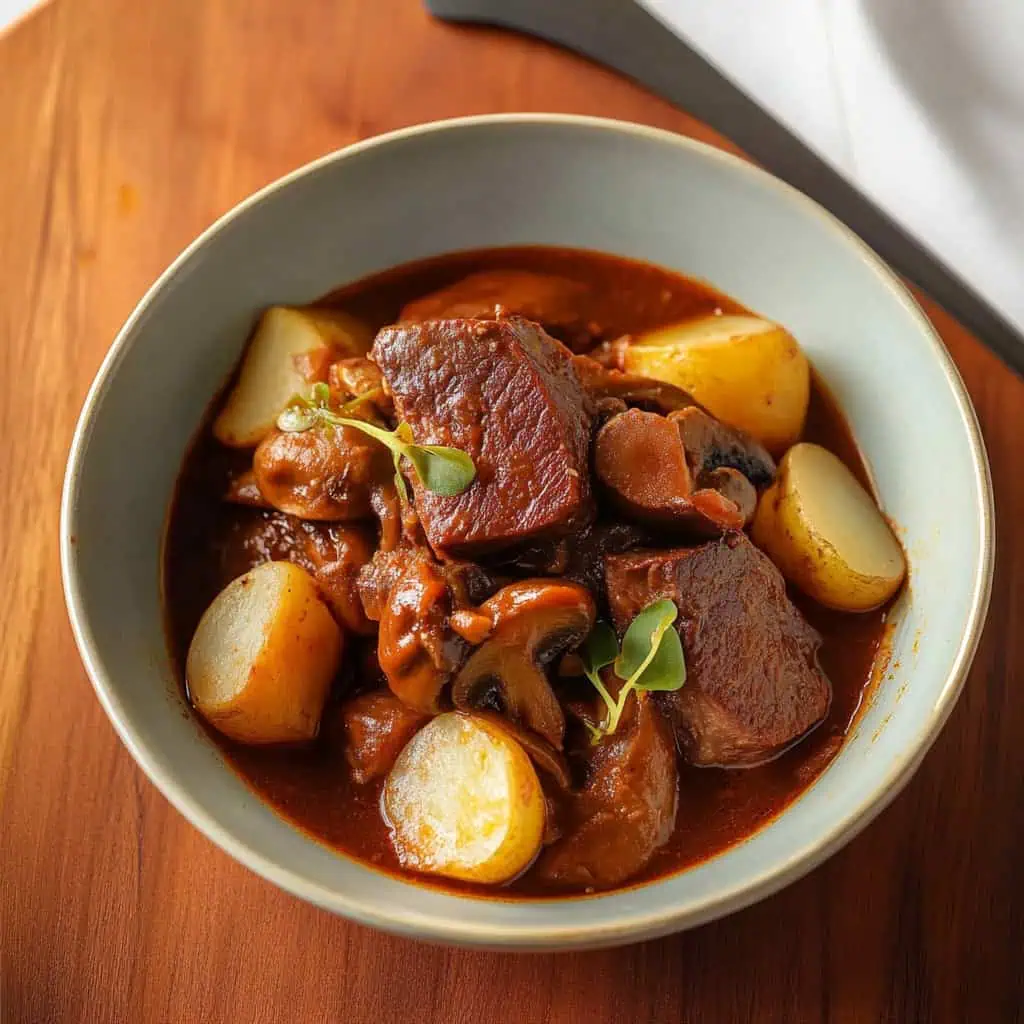
Why You'll Love This Recipe
- Melt-in-your-mouth tender meat that transforms humble ingredients into an elegant dish
- Make-ahead friendly - can be prepared in stages
- Impressive centerpiece for special occasions
- Rich, complex flavors that develop during slow cooking
- Budget-friendly way to serve premium restaurant-quality food at home
Ingredients
Each ingredient in this recipe serves a specific purpose in creating the perfect Lengua Estofado. The beef tongue provides a uniquely tender texture when slow-cooked, while aromatics like onion, garlic, bay leaves, and peppercorns infuse the meat with deep flavor during the initial cooking.
Potatoes add heartiness and absorb the rich sauce, while mushrooms contribute an earthy umami quality. The sauce combines tomato, soy sauce, and reserved cooking broth for depth, with a touch of sugar to balance acidity.
This careful selection creates a harmonious blend of flavors that's both comforting and sophisticated.
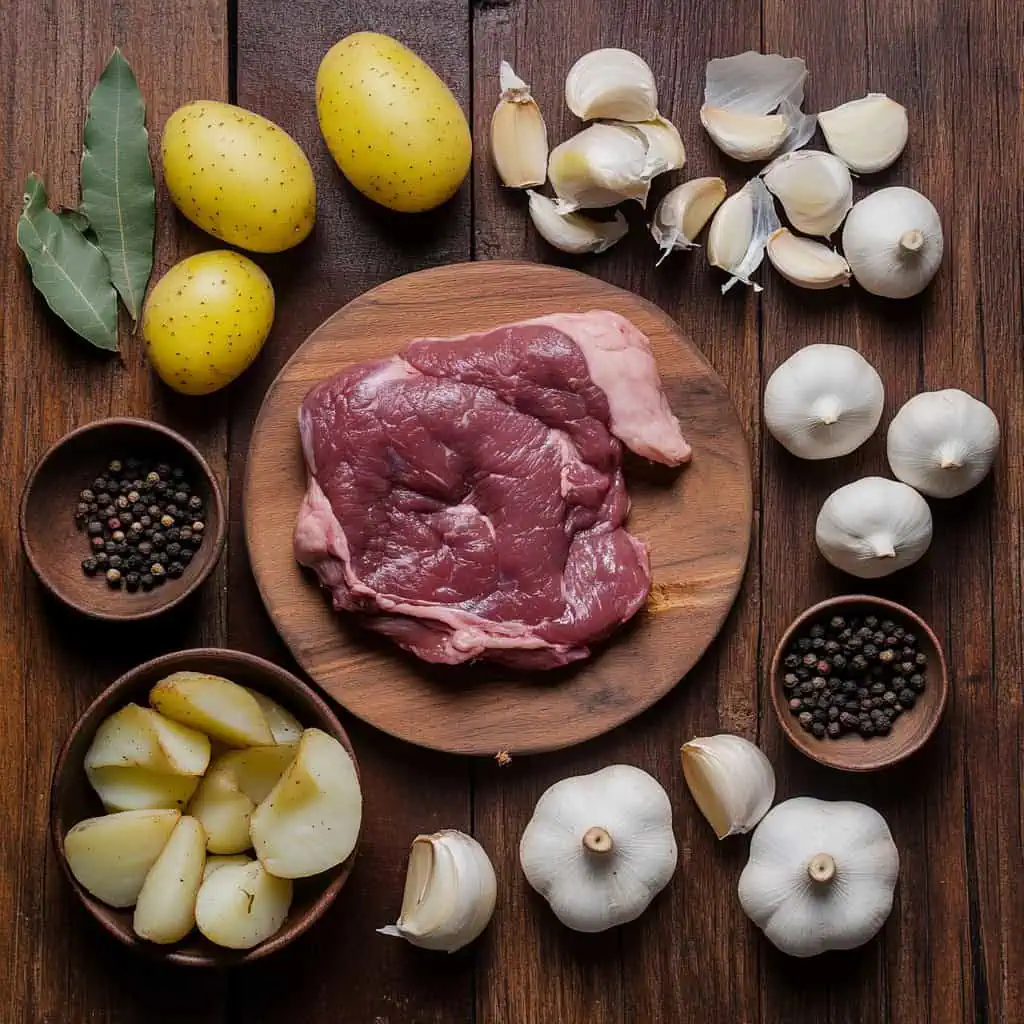
- 3 pounds beef tongue
- 1 small onion, peeled and quartered
- 1 head garlic, peeled and crushed
- 2 bay leaves
- 1 teaspoon peppercorns
- 2 tablespoons salt
- Water (enough to cover)
- ¼ cup canola oil
- 2 medium potatoes, peeled and sliced into ½-inch thick rounds
- 1 can (4 ounces) button mushrooms, drained
- 1 small onion, peeled and chopped
- 2 cloves garlic, peeled and minced
- 1 cup tomato sauce
- 1 cup reserved broth from cooking the tongue
- 2 tablespoons soy sauce
- 1 tablespoon sugar
- Salt and pepper to taste
Equipment
- Large heavy-bottomed pot - For the initial long cooking process to tenderize the tongue
- Pressure cooker (optional) - Reduces cooking time from 4-5 hours to about 60 minutes
- Sharp knife and cutting board - For slicing the cooked tongue into even pieces
- Vegetable peeler - Helps remove the outer skin from the cooked tongue
- Strainer or colander - For draining the tongue after boiling
- Measuring cups and spoons - For precise measurements of ingredients
- Large skillet or braising pan - For making the sauce and completing the dish
- Kitchen tongs - For easily handling and turning the meat
- Meat thermometer (optional) - To ensure proper cooking temperature
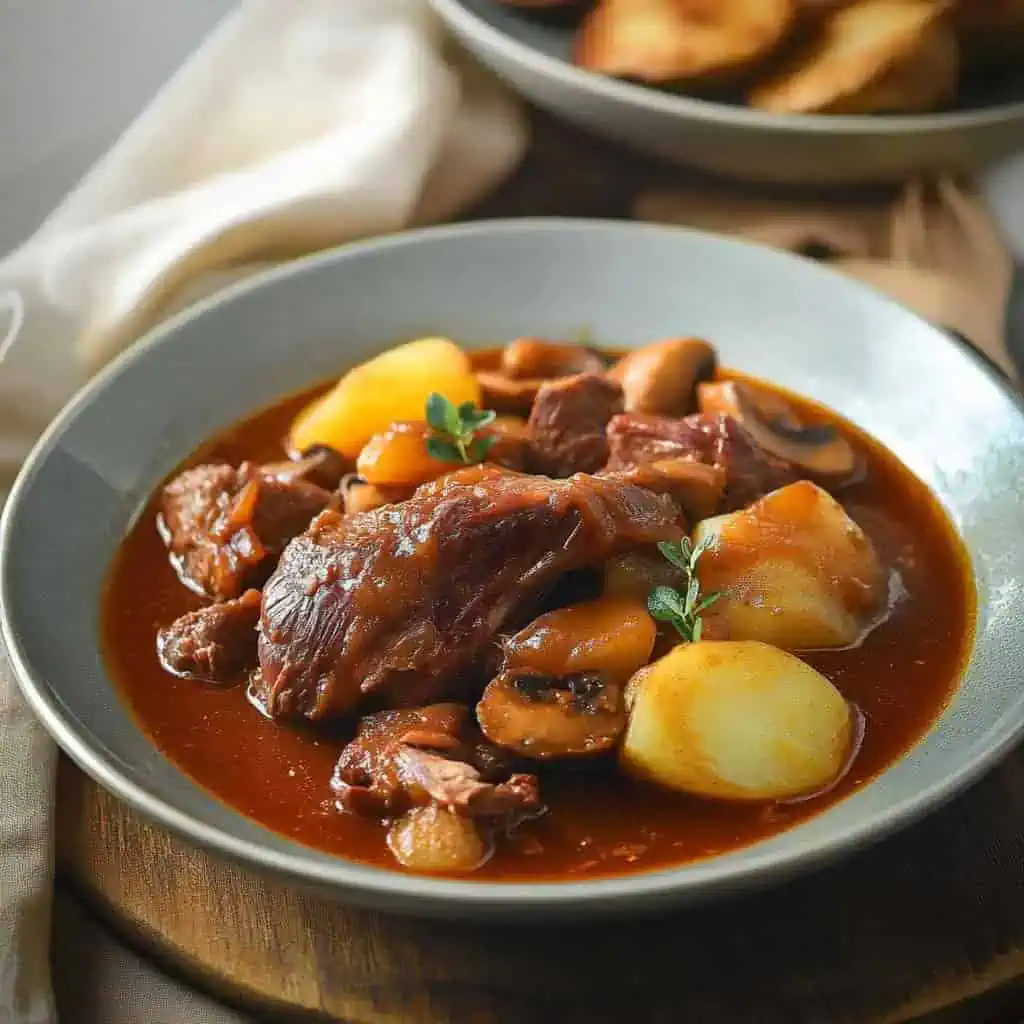
How To Make
- Place beef tongue in a deep pot and cover with water. Bring to a rolling boil (100°C/212°F) for 10-15 minutes. Drain and rinse the tongue thoroughly, then clean the pot for reuse.
- Return the tongue to the clean pot and add fresh water to cover. Add quartered onion, crushed garlic, bay leaves, peppercorns, and salt. Bring to a boil, then reduce to low heat (90°C/195°F). Simmer covered for 4-5 hours until fork-tender, adding water as needed.
- Remove tongue from broth, reserving 1 cup of the cooking liquid. Let cool slightly until manageable, then peel the skin while still warm. Refrigerate for 1-2 hours until firm, then slice diagonally into ½-inch pieces.
- Heat canola oil in a large skillet over medium heat (175°C/350°F). Fry the sliced potatoes until golden brown; set aside. In the same pan with 2 tablespoons oil, sauté mushrooms for 1 minute and set aside. Cook chopped onions and garlic until soft, then brown the sliced tongue for 3-4 minutes.
- Add tomato sauce, the reserved broth, and soy sauce. Bring to a boil, then reduce heat to low (140°C/285°F). Simmer covered for 10-15 minutes. Add sugar, salt, and pepper to taste. Return potatoes and mushrooms to the pan.
- Cook until the sauce thickens enough to coat the back of a spoon. Let rest for 5-10 minutes before serving. The internal temperature of the meat should reach 74°C/165°F when reheating.

Tips from Lola's Kitchen
- Choose the right tongue: Look for one with a bright pink color and no dark spots
- Pre-soak the tongue: Soak in cold water for 1 hour before cooking to remove any blood
- Use vinegar: Add a splash while boiling to help tenderize the meat
- Score for flavor: Make shallow cuts on the underside of the tongue before cooking for better flavor absorption
- Patience is key: Don't rush the initial cooking process - slow and steady produces the most tender results
- Peel while warm: The outer skin is much easier to remove when the tongue is still warm
- Slice when cold: Refrigerating before slicing helps achieve clean, even cuts
- Taste as you go: Adjust seasoning gradually, especially the salt and sugar balance
Substitutions
- Meat: Pork tongue can be used (cooking time reduces by 1-2 hours), or beef cheeks
- Mushrooms: Fresh mushrooms instead of canned (sauté longer until moisture evaporates)
- Broth: Beef stock works if you don't have enough reserved cooking liquid
- Tomato sauce: Use 2 tablespoons tomato paste mixed with ¾ cup water
- Soy sauce: Coconut aminos make a great gluten-free alternative
- Oil: Any neutral oil can replace canola oil
- Potatoes: Sweet potatoes or turnips create interesting flavor variations
- Sugar: Brown sugar or honey can replace white sugar for a deeper flavor
Troubleshooting
- Tough meat: The tongue is not cooked long enough. Increase cooking time by 30-minute intervals until fork-tender.
- Sauce too thin: Simmer uncovered to reduce, or add 1 teaspoon cornstarch mixed with 1 tablespoon cold water.
- Sauce too thick: Add reserved broth gradually until desired consistency is reached.
- Tongue difficult to peel: Either cook longer or steam for 5 minutes to loosen the skin.
- Bland flavor: Add more soy sauce, a splash of vinegar, or extra garlic to enhance flavors.
- Greasy sauce: Let the stew rest for 10 minutes, then skim fat from the surface before serving.
Storage & Reheating
- Refrigerator: Store in an airtight container for 3-4 days.
- Freezer: Freeze for up to 3 months. For best results, store meat and sauce separately.
- Thawing: Thaw overnight in the refrigerator before reheating.
- Reheating: Warm gently on the stovetop over medium-low heat until the internal temperature reaches 165°F (74°C).
- Moisture: Add a few tablespoons of broth when reheating to maintain juiciness.
- Flavor enhancement: A fresh sprinkle of chopped parsley or a squeeze of lemon can brighten reheated servings.
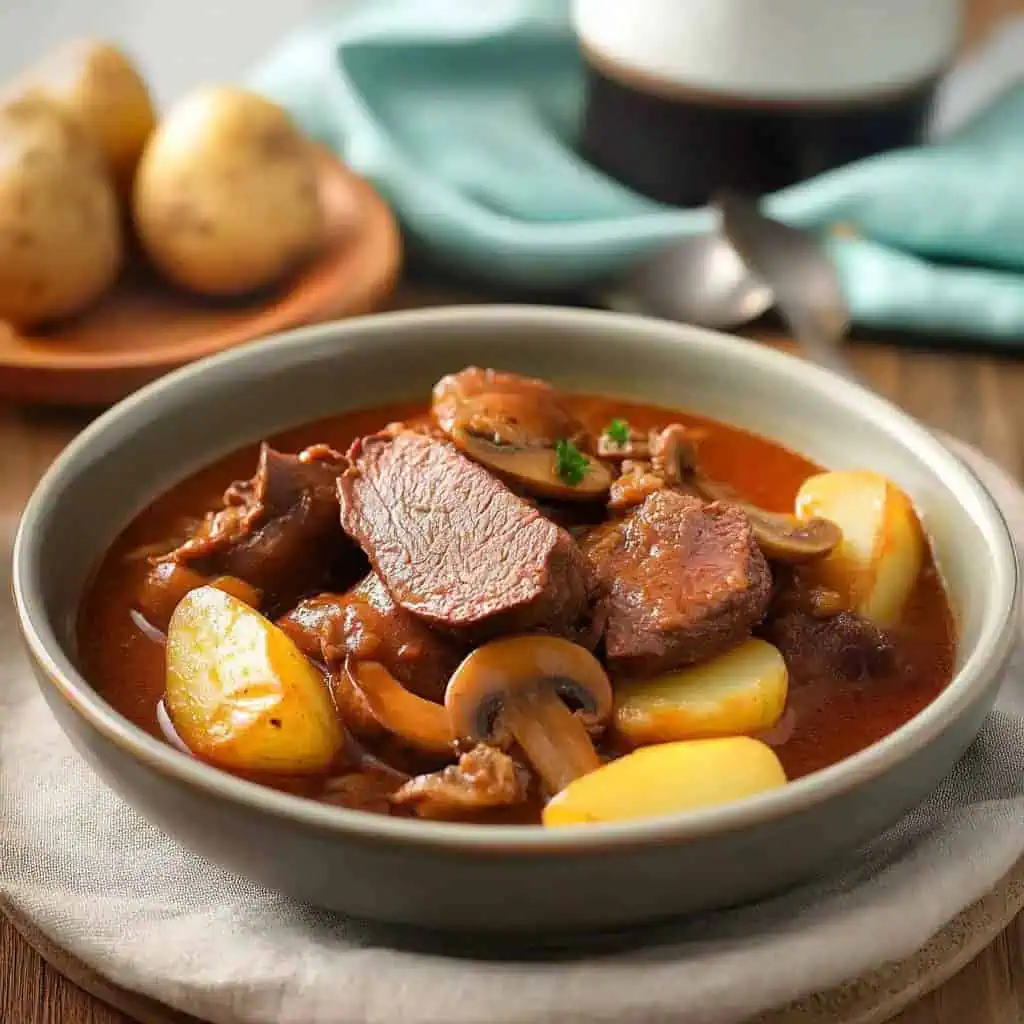
FAQ
Is ox tongue hard to cook?
While cooking ox tongue requires time and patience, the process itself is straightforward. The key is proper cleaning and long, slow cooking to achieve tenderness. Following our detailed temperature guidelines and cooking times will help you achieve restaurant-quality results.
Where can I buy ox tongue?
You can find ox tongue at specialty butcher shops, some Asian markets, or by special order at major grocery stores. Ask your butcher for a fresh, pink-colored tongue without any dark spots. For best results, choose a tongue weighing between 2.5 to 3.5 pounds.
Can I make Lengua Estofado ahead of time?
Yes! In fact, the flavor improves after a day in the refrigerator. You can cook the tongue up to 2 days ahead, slice it, and store it in an airtight container. Make the sauce and complete the dish the day you plan to serve it.
How do I know when the tongue is properly cooked?
The tongue is done when a fork easily pierces the thickest part with little resistance. You can also use a meat thermometer – it should read 165°F (74°C) at the thickest part. The skin should peel away easily when warm.
What if I can't peel the skin off easily?
If the skin is difficult to remove, the tongue might need more cooking time. Return it to the broth and cook for another 30 minutes. Alternatively, steam the tongue for 5 minutes to loosen the skin.
Can I use a pressure cooker or Instant Pot?
Yes! Using a pressure cooker reduces cooking time from 4-5 hours to about 60 minutes. Cook on high pressure and ensure you have enough liquid to cover the tongue. Natural pressure release is recommended for tender results.
Why did my sauce turn out too thin/thick?
For thin sauce: Simmer uncovered until it reaches desired consistency. For thick sauce: Gradually add more reserved broth until you reach the right consistency. The sauce should coat the back of a spoon but still be pourable.
Can I add other vegetables to the dish?
Absolutely! Bell peppers, carrots, or olives make excellent additions. Add firmer vegetables like carrots earlier in the cooking process, and more delicate ones like bell peppers toward the end.
Is this dish spicy?
Traditional Lengua Estofado is not spicy, but you can easily add heat by incorporating chopped bird's eye chilies or red pepper flakes to suit your taste preference.
How do I make this dish more special for occasions?
For a more luxurious version, add ½ cup of red wine to the sauce, incorporate a variety of mushrooms, or finish with ½ cup of heavy cream just before serving. Garnish with fresh herbs and serve on your best china.
Related
Looking for other recipes like this? Try these:

Lengua Estofado (Filipino Ox Tongue Stew)
Equipment
- Large heavy-bottomed pot (for traditional cooking) or pressure cooker
- Sharp knife and cutting board (Para sa paghiwa / For slicing)
- Vegetable peeler (Pantalop / For peeling the tongue)
- Strainer or colander (Salaan / For draining)
- Measuring cups and spoons (Panukat)
- Large skillet or braising pan
- Kitchen tongs (Para sa pagbabaliktad ng karne / For turning meat)
- Meat thermometer (optional but recommended)
Ingredients
For Cooking the Tongue
- 3 pounds beef tongue dila ng baka
- 1 small onion peeled and quartered
- 1 head garlic peeled and crushed
- 2 bay leaves dahon ng laurel
- 1 teaspoon peppercorns paminta
- 2 tablespoons salt
- Water enough to cover
For the Stew
- ¼ cup canola oil
- 2 medium potatoes peeled and sliced into ½-inch thick rounds
- 1 can 4 ounces button mushrooms, drained
- 1 small onion peeled and chopped
- 2 cloves garlic peeled and minced
- 1 cup tomato sauce
- 1 cup reserved broth from cooking the tongue
- 2 tablespoons soy sauce
- 1 tablespoon sugar
- Salt and pepper to taste
Instructions
- Place 3 pounds of beef tongue (dila ng baka) in a deep pot and cover with water. Bring to a rolling boil (100°C/212°F) for 10-15 minutes. Drain and rinse the tongue thoroughly, then clean the pot for reuse.
- Return the tongue to the clean pot and add fresh water to cover. Add 1 small quartered onion, 1 head crushed garlic, 2 bay leaves (dahon ng laurel), 1 teaspoon peppercorns (paminta), and 2 tablespoons salt. Bring to a boil, then reduce to low heat (90°C/195°F). Simmer covered for 4-5 hours until fork-tender, adding water as needed.
- Remove tongue from broth, reserving 1 cup of the cooking liquid. Let cool slightly until manageable, then peel the skin while still warm. Refrigerate for 1-2 hours until firm, then slice diagonally into ½-inch pieces.
- Heat ¼ cup canola oil in a large skillet over medium heat (175°C/350°F). Fry the sliced potatoes until golden brown; set aside. In the same pan with 2 tablespoons oil, sauté mushrooms for 1 minute and set aside. Cook chopped onions and garlic until soft, then brown the sliced tongue for 3-4 minutes.
- Add 1 cup tomato sauce, the reserved broth, and 2 tablespoons soy sauce. Bring to a boil, then reduce heat to low (140°C/285°F). Simmer covered for 10-15 minutes. Add 1 tablespoon sugar, salt, and pepper to taste. Return potatoes and mushrooms to the pan.
- Cook until the sauce thickens enough to coat the back of a spoon. Let rest for 5-10 minutes before serving. The internal temperature of the meat should reach 74°C/165°F when reheating.
Tips from Lola's Kitchen
- Choose a tongue with a bright pink color and no dark spots
- Soak the tongue in cold water for 1 hour before cooking to remove any blood
- Add a splash of vinegar while boiling to help tenderize the meat
- Score the underside of the tongue before cooking for better flavor absorption
Nutrition
The Story Behind Lengua Estofado
Lengua Estofado stands as a testament to the Philippines' rich colonial heritage, where Spanish culinary traditions merged seamlessly with Filipino cooking methods. This ox tongue stew, known locally as "estofadong dila," emerged during the 333-year Spanish colonial period, when European cooking techniques transformed the landscape of Filipino cuisine.
In Spanish kitchens, "estofado" refers to a method of braising meat in wine or stock, often with tomatoes and aromatics. When this technique reached Philippine shores, local cooks adapted it using indigenous ingredients and their own culinary intuition. The choice of ox tongue as the primary meat reflects both Spanish influence and Filipino resourcefulness – turning what was once considered a humble cut into a prestigious dish.
During the Spanish era, this dish became a staple at the tables of affluent Filipino families, particularly during fiestas and special occasions. The long, careful cooking process and the relatively expensive cut of meat elevated Lengua Estofado to its status as celebration food. Filipino cooks mastered the art of tenderizing the tongue through slow cooking, creating a dish that would become synonymous with Filipino hospitality and celebration.
Today, Lengua Estofado continues to hold its place as a treasured recipe in Filipino cuisine. While it's still commonly served at important gatherings and holiday celebrations, many home cooks are rediscovering this classic dish, appreciating both its rich history and the way it transforms a challenging cut of meat into something extraordinarily tender and flavorful. Modern interpretations might include variations in cooking methods – such as using pressure cookers to reduce cooking time – but the essence of this beloved dish remains unchanged.
The enduring popularity of Lengua Estofado in Filipino cuisine speaks to its perfect balance of foreign influence and local taste, making it a true representation of Filipino food culture. Whether served at a grand celebration or a special family dinner, this dish continues to tell the story of Filipino culinary evolution, one tender bite at a time.
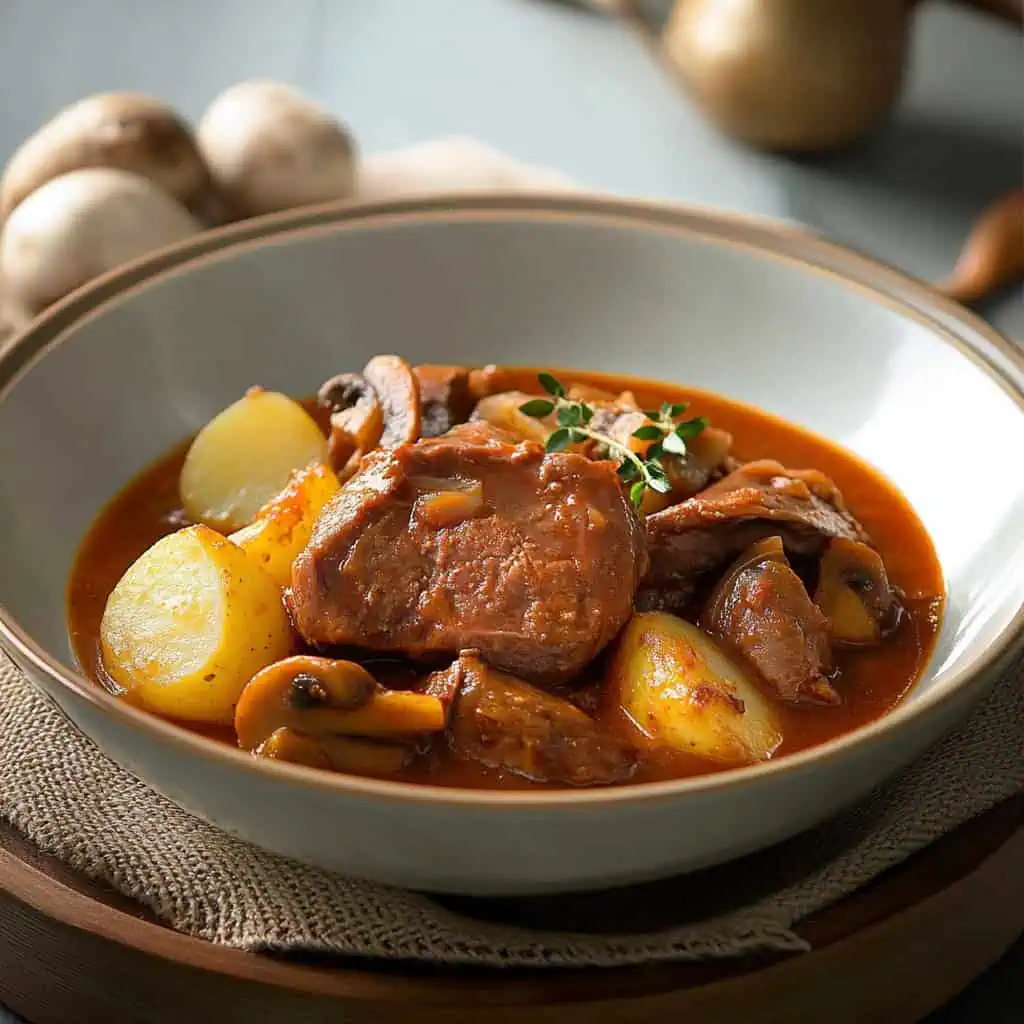









Comments
No Comments